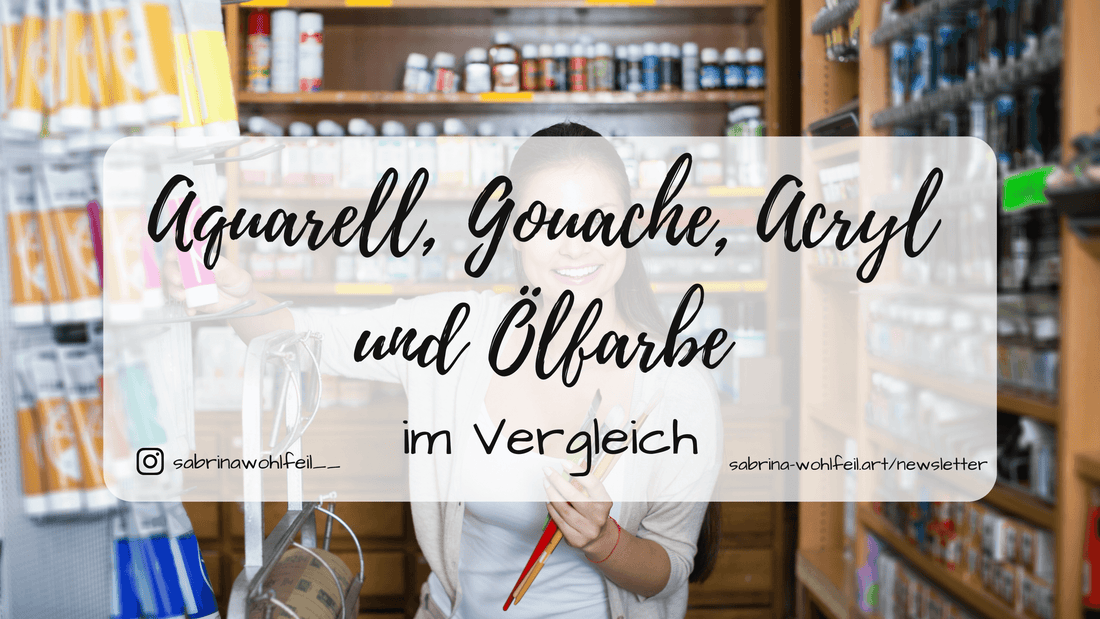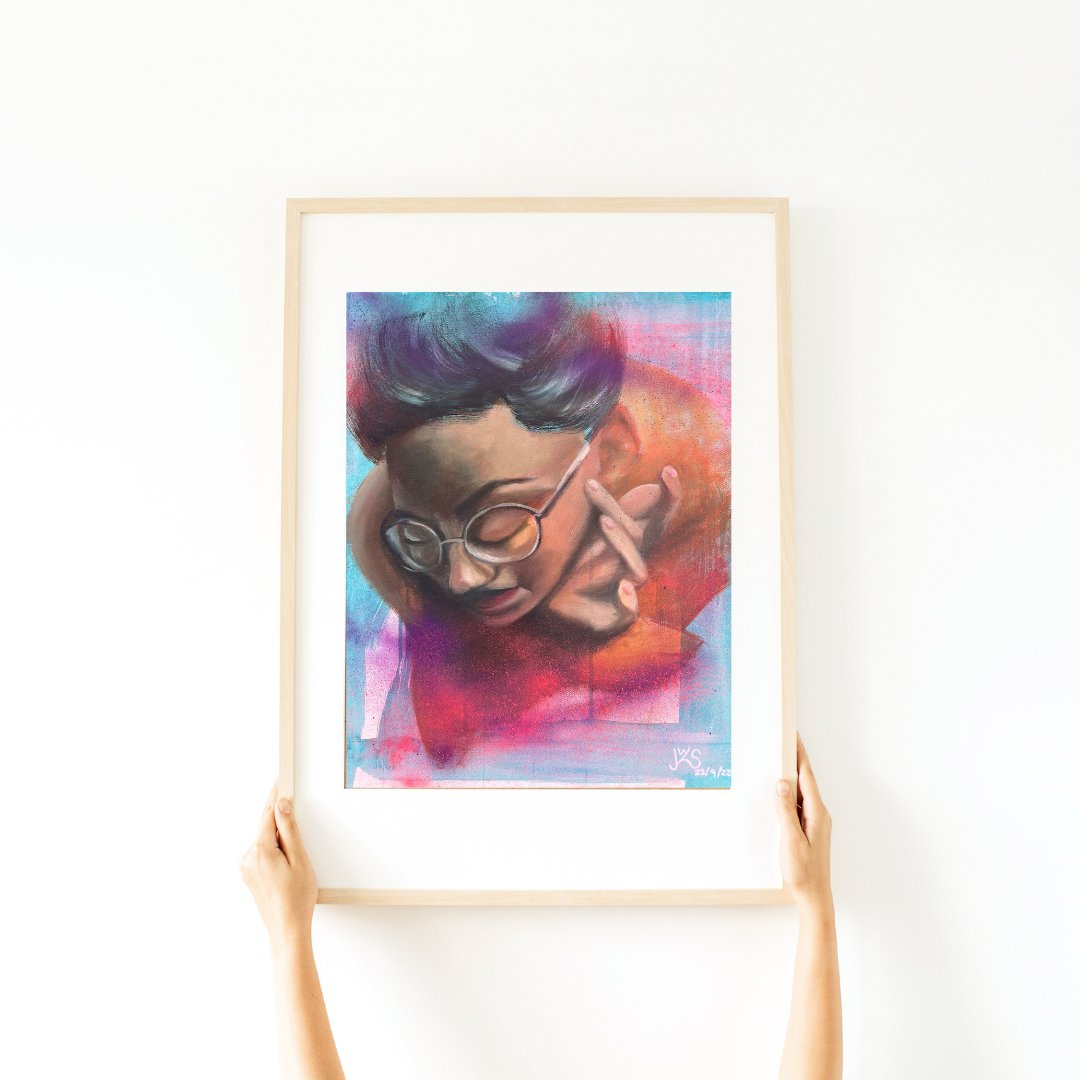
Watercolor, gouache, acrylic and oil paint - what is the difference?
Share
What is the difference between watercolor and gouache? Does gouache cover as well as acrylic? And is acrylic better than oil paint? I'll try to clear that up here - or at least share my experiences with you.
Because there is no better or worse in art. There is also no acrylic team or oil paint team - but everyone has their own preferences. There are artists who limit themselves to one medium. And then there are people like me who do one thing today and another tomorrow - and the next day everything together.
Basic recipe for every color
In principle, a paint requires a pigment - the actual colorant, a solvent - which makes the paint paintable and can be removed again - and a binding agent that ensures that the pigment and solvent mix well and that the paint then adheres to the medium to which it is supposed to adhere. This can then be supplemented by fillers - substances that either increase the volume or influence other desired properties of the finished paint - and water.
Watercolor paint
I have already explained some of the basics here. In watercolor, the colors consist of the pigment, water-soluble binding agents (eg gum arabic) and some fillers. The solvent for watercolor is water, so watercolor is a water-soluble color - which is why watercolor can be activated again and again when water is applied.
Watercolor paint dries solid when it is filled into pans - tube paint contains a little water so that the paint can be taken out of the tube. You can save a little money by buying large tubes and filling empty pans yourself. It's cheaper in terms of calculations. But it's not worth it if it's a color that you don't use very often.
Fillers used include humectants and flow agents, which influence the surface tension of the water so that the paint can flow wonderfully and drying is delayed. In reality, however, manufacturers are very tight-lipped about this; a popular agent for improving the flow of paint is ox gall - but some manufacturers also have synthetic substitutes in their range. Ultimately, however, it is not clear what is in paints.
Watercolors dry lighter than they look when wet - this is because the sheen of the water makes the colors appear darker. Once it evaporates, the color appears lighter.
Famous watercolor artists
-
Albrecht Durer, 1471 - 1528
-
William Turner, 1775 - 1851
-
Emil Nolde, 1867-1956
-
Maria Sibylla Merian, 1647 - 1717
gouache
In other words: Guu-aasch - difficult word, easy to explain - an opaque, water-soluble paint. The solvent is water, pigments bring the color into play. Something water-soluble is needed as a binding agent, which is why gum arabic is often used here.
Wait a minute - what is the difference to watercolor? It lies in the filler - because so that the colors can paint opaquely, traditionally painted chalk is added to gouache - nowadays other white powders can be used instead of chalk (ok, that sounds strange now...)
These fillers lead to the classic characteristic of gouache painting - the final result has a matt, powdery effect when applied. Otherwise, gouache can be applied alla prima (i.e. straight from the tube without underpainting), but it is recommended to thin it to save paint. If it has a honey-like consistency, gouache still covers well, but the more water, the more transparent the paint application becomes.

Wet-on-wet is also possible - but it will never look like watercolor. The colors never look as airy as with watercolor because they get that chalky finish. A tip - with gouache, the pigment quality is even more important than with watercolor - I had to start with the cheapest of all gouache colors when I was studying. The secondary colors already had a grayish tint - I gave the colors to my son's kindergarten after I finished my studies. Last year I won a voucher for the art park - and treated myself to a good gouache set. And I'm totally in love. There's no comparison.
Be careful when painting opaquely - a bold stroke in one direction, don't scrub back and forth. When you paint, you'll dissolve the lower layer again and then you'll get a different color or an unwanted grayish/dirty look. If necessary, add another layer of the lighter color after it's dried.
Gouache usually comes in tubes, less often in pans. For a few years now, so-called “jelly gouache” has been trendy - the individual colors come in a kind of small yogurt cup (like the sauces in fast food restaurants). The consistency is exactly like gouache from a tube.
Gouache is a water-soluble paint and, due to the chalk content, usually dries lighter than it appears when wet.
Famous Gouache Artists
-
Adolph von Menzel, 1815 - 1905
-
Max Lieberman, 1847 - 1935
-
Marc Chagall, 1887 - 1985
-
Paul Wunderlich, 1927 - 2010
Acrylic paint
The youngest of the four classic types of paint in art. They consist of an aqueous acrylic resin dispersion that acts as a binding agent. This initially dries to a milky white color and becomes transparent after hardening. Therefore, unlike water-soluble watercolor and gouache paints, acrylic paints become darker after hardening.
Acrylic paints are water-soluble and water-dilutable - however, they are not water-soluble once the acrylic resin has hardened. They are usually opaque (depending on the pigment and color) and can be painted in a similar way to gouache. However, if gouache is applied too thickly, there is a risk of cracking. This does not apply to acrylic paints - they can also be applied in a pasty manner and with a structure. For really interesting structures, there are also painting aids such as structure pastes.
Acrylic paints dry very quickly, so they are super easy to apply in layers - unlike oil paints, there are no rules about how thick/thin the individual layers can be. Acrylic paints also dry very quickly - an advantage over oil paint, which takes up to a year to fully harden. If you want to extend the open time, there are so-called retarders, i.e. drying retarders, that you can add to your paints.

Acrylic resin paints have only been available in art supplies since 1940, but they have become a classic in art. Oil painters use them for underpainting to reduce the amount of time needed for the overall work. In abstract art, they are often used with structural agents to create three-dimensional images with a short drying time. And for beginners, they are often touted as the medium - because they have many advantages that make painting easy and intuitive.
Famous Acrylic Artists
-
Andy Warhol, 1928 - 1987
-
Roy Lichtenstein, 1923 - 1997
-
Mark Rothko, 1903 - 1970
-
Bridget Riley, born 1931
Oil paint
Often referred to as the high school of painting - because they have the reputation of requiring a lot of experience to master and requiring complex processing. However, this is not necessarily true.
They consist of drying oils as a binding agent and the color-giving pigment. Drying oils harden and, together with the pigments, form the desired color layer - but the hardening process can take time. Even with diluted layers, it can take several days, and with thicker layers of paint, it can take years or even decades.
The long open time, however, allows for very unique techniques - even in oil painting there are wet-on-wet techniques, which you will certainly be familiar with if you have ever seen Bob Ross. And this example shows that it is not that complicated - because these pictures are painted in one step.
I usually paint using the alla prima technique - I paint all the layers together while they are still wet, and only mix some of the colors on the canvas. That way I can finish in one day - the picture still has to dry for a long time, but that can be done in a quiet corner on the easel.
The well-known old masters such as Leonardo Davinci used what is known as layered painting - here an underpainting with shadows and light areas is first applied, then the remaining layers are gradually applied. The rule is thick on thin - in the bottom layer, the oil paints are heavily thinned with thinner, in each subsequent layer more oil is added as a painting medium so that the paint becomes "fatter". If you were to layer the other way round, cracks would form in the layers - due to the drying times mentioned. This method of working requires a lot of planning - and time. When the paint is "touch dry", i.e. no longer feels sticky when you feel it with the back of your hand, an intermediate varnish can be applied. The final varnish should not be applied for at least a year.
In contrast to acrylic paints, oil paints are often worked with siccatives, so-called drying accelerators.
Another supposed disadvantage of oil paints - they are thinned with solvents and the brushes have to be washed out with turpentine. Classic oil paints cannot be diluted with water or painted over, that's true. However, turpentine is no longer necessarily needed as a thinner/solvent. My favorite is the Green for Oil series from Sennelier, which has solvent-free thinners as well as a liquid and a pasty painting medium. There are also other great odorless thinners - Gamsol from Gamblin or Chelsea Classic Studio Lavender Spike Oil - which smells wonderful like grandma's.
Relatively new on the market are products that make classic oil paints water-soluble - or even entire lines with water-soluble artist's paints (they're on my birthday wish list, so I'll report back). With the right technique, you can even paint acrylic and oil paints over and into each other - like in my work Nora:
Mixed Media Acrylic/ Oil Paint
If oil is heavily diluted with solvent, it can be painted over with acrylic almost immediately after drying - the important thing is to apply it very diluted. This technique is used by the artist Nikolas Antoniou , who offers a course on it at Domestika.
Oil paint offers so many possibilities that it seems quite complex at first glance - but it is by no means unsuitable for beginners. I personally even see many of the disadvantages that are always mentioned in comparison to acrylic as advantages.
Famous painters who worked with oil paints:
-
Jan Vermeer, 1632 - 1675
-
Vincent Van Gogh, 1853 - 1890
-
Claude Monet, 1840 - 1926
-
Leonardo Da Vinci, 1452 - 1519
Phew, that was a lot of text - I hope the overview helps you find the right color for you - if you have any questions, please write them in the comments. I will also report on the individual colors in more detail and show the differences using examples.
Feel free to write me suggestions and requests in the comments about what else I should write about.
Until the next article, stay creative!
Sabrina




